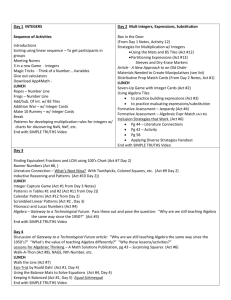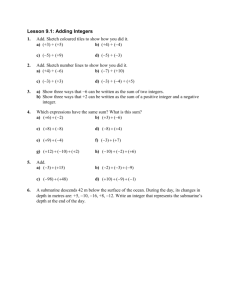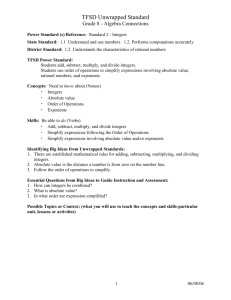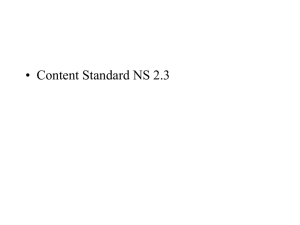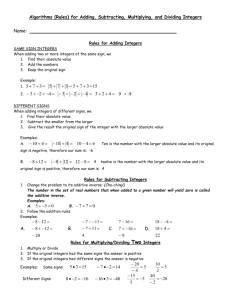PATTERNS WITH INTEGERS - Connecticut Core Standards
advertisement
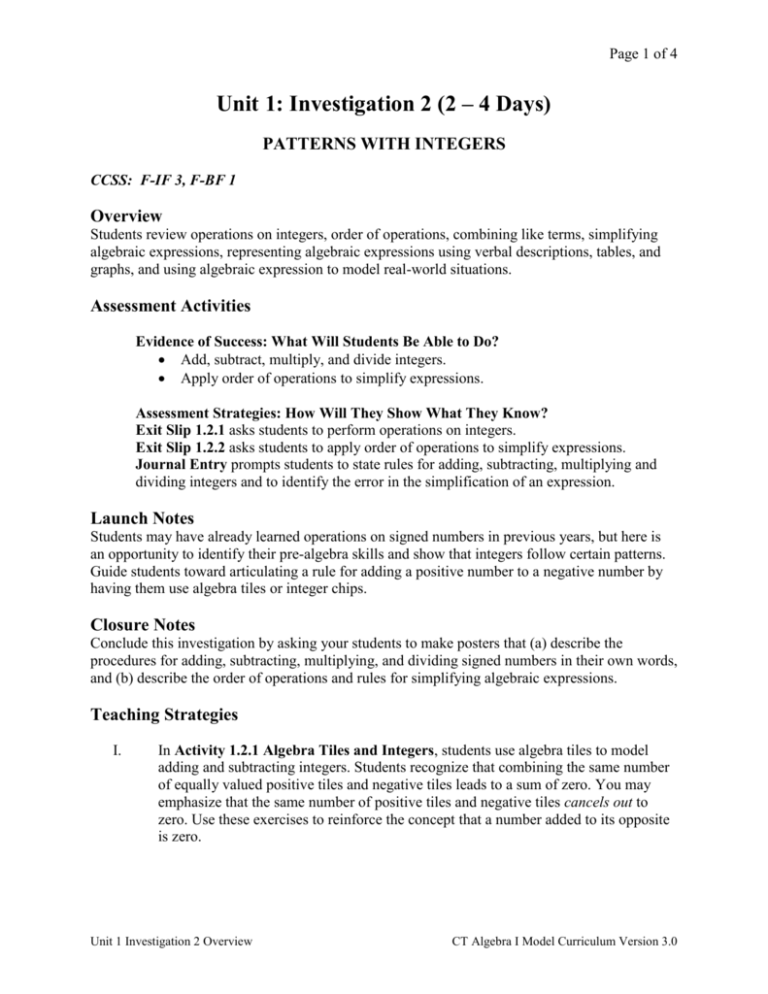
Page 1 of 4 Unit 1: Investigation 2 (2 – 4 Days) PATTERNS WITH INTEGERS CCSS: F-IF 3, F-BF 1 Overview Students review operations on integers, order of operations, combining like terms, simplifying algebraic expressions, representing algebraic expressions using verbal descriptions, tables, and graphs, and using algebraic expression to model real-world situations. Assessment Activities Evidence of Success: What Will Students Be Able to Do? Add, subtract, multiply, and divide integers. Apply order of operations to simplify expressions. Assessment Strategies: How Will They Show What They Know? Exit Slip 1.2.1 asks students to perform operations on integers. Exit Slip 1.2.2 asks students to apply order of operations to simplify expressions. Journal Entry prompts students to state rules for adding, subtracting, multiplying and dividing integers and to identify the error in the simplification of an expression. Launch Notes Students may have already learned operations on signed numbers in previous years, but here is an opportunity to identify their pre-algebra skills and show that integers follow certain patterns. Guide students toward articulating a rule for adding a positive number to a negative number by having them use algebra tiles or integer chips. Closure Notes Conclude this investigation by asking your students to make posters that (a) describe the procedures for adding, subtracting, multiplying, and dividing signed numbers in their own words, and (b) describe the order of operations and rules for simplifying algebraic expressions. Teaching Strategies I. In Activity 1.2.1 Algebra Tiles and Integers, students use algebra tiles to model adding and subtracting integers. Students recognize that combining the same number of equally valued positive tiles and negative tiles leads to a sum of zero. You may emphasize that the same number of positive tiles and negative tiles cancels out to zero. Use these exercises to reinforce the concept that a number added to its opposite is zero. Unit 1 Investigation 2 Overview CT Algebra I Model Curriculum Version 3.0 Page 2 of 4 Differentiated Instruction (For Learners Needing More Help) Activity 1.2.1 Algebra Tiles and Integers enables students to use algebra tiles to model and understand adding and subtracting integers. II. Activity 1.2.2 Patterns in Signed Numbers allows students to discover rules for adding, subtracting, multiplying, and dividing integers. The activity provides series of exercises in which students explore transitions from positive sums to negative sums, positive differences to negative differences, positive products to negative products, and positive quotients to negative quotients. Students also discover the rule that subtracting a negative number is equivalent to adding its opposite. To help students discover a rule for subtracting negative integers, discuss subtraction as the difference between two items, such as a measure of how much the temperature changed. Ask students what is the difference between the end temperature of 5 degrees and beginning temperature of 4 degrees (5 – 4 = 1). This means that over a period of time, the temperature increased by 1. The difference between the end temperature of 4 degrees and the beginning temperature of 5 degrees would be 4 - 5= -1, or a drop in temperature of 1 degree. Consider the difference between the end temperature of 5 degrees and a start temperature of 1 degree below zero. By tracing the degree marks between -1 and 5, students can discover that they have to move from -1 to 0, and then move from 0 to 5. The overall change is 6 units. Thus 5 – (-1) = 5 + 1 = 6. Subtracting negative one is equivalent to adding one. (From Craine, McGowan, and Ruben, Elementary and Intermediate Algebra, Houghton Mifflin, pp.2-6 2003) For the more abstract thinkers explain subtraction of negative numbers by establishing the connection between subtracting a number from itself and adding opposites. For example -5 + 5 = 0 since -5 and 5 are opposites. But we also know that -5 – (-5) = 0 since any number minus itself is zero. So if -5 + 5 = 0, and -5 – (-5) = 0, adding 5 is equivalent to subtracting -5. Differentiated Instruction (For Learners Needing More Help) Activity 1.2.2 Patterns in Signed Numbers reviews rules for adding. Subtracting, multiplying and dividing signed numbers. Differentiated Instruction (Enrichment) Provide students expressions to simplify which contain fractions and decimals. III. In Activity 1.2.3 Bingo with Order of Operations, students use the order of operations to play a Bingo game. Each student sets up their own Bingo card by selecting a free space on the card and choosing numbers between 1 and 50 to fill in cells in the remaining cells. The numbers in each cell represents a solution to a Unit 1 Investigation 2 Overview CT Algebra I Model Curriculum Version 3.0 Page 3 of 4 mathematical expression. Students are presented a list of mathematical expressions, and they pick out the expressions that correspond to their solutions. A correct match enables the student to cross off the number on their Bingo card. The first student who gets a regular Bingo (correct matches in each column) is the winner. IV. You may have students play Exploring Krypto, a game that allows students to create expressions using multiple operations. Given a random target number and five random integers, students must create an expression equivalent to the target number which uses the five integers exactly once. Require correct answers to be written in proper notation. Go to the NCTM Illuminations website below for a copy of the game. http://illuminations.nctm.org/LessonDetail.aspx?id=L803 After students play a few rounds of Krypto, you may ask students to evaluate expressions that generate common errors. Use examples like 30 · 5 ÷ 6, 30 ÷ 5· 6, 8 – 3 + 2, and 3 + 5(3+1)2 Discuss the difference between –52 and (–5)2. Also discuss what happens when the expression inside the parenthesis cannot be simplified, such as 3 + (5)2. Note on PEMDAS: Some students may have learned the mnemonic “Please Excuse My Dear Aunt Sally” (or PEDMAS) to remember this order. Unfortunately this can lead to mistakes unless students realize that multiplication and division go together as do addition and subtraction. (Note that division is the inverse operation for multiplication and subtraction is the inverse of addition.) To overcome this misconception you might want to teach the mnemonic as “Please Excuse My Aunt” What kind of aunt is she? A dear Aunt! So division (dear) goes with multiplication (my). And what is the aunt’s name? Sally! So subtraction goes with addition. You may provide students additional practice simplifying expressions using the order of operations. Activity 1.2.4 Order of Operations provides expressions for students to simplify. In this activity, the following instructions are provided. ORDER OF OPERATIONS Grouping – Simplify inside the parenthesis or other grouping symbol (fraction bar or radical) Exponents – Evaluate the exponent Multiplication and Division – Do these operations as they appear from left to right Addition and Subtraction - Do these operations as they appear from left to right V. In Activity 1.2.5 Lifting Weights, students model a real-world situation using an algebraic expression, explore multiple representations of the same expression, and explore patterns using a table and graph. As a launch to this activity, consider bringing in an object that weighs a gram, ounce, pound and kilogram. Or ask students to identify the conversion factor between kilograms and pounds. VI. In Activity 1.2.6 Patterns in Arithmetic, students review the relationship between multiplication and repeated addition and repeated subtraction, and the relationship Unit 1 Investigation 2 Overview CT Algebra I Model Curriculum Version 3.0 Page 4 of 4 between exponents and repeated multiplication. Students translate verbal descriptions into mathematical expressions. Group Activity Activity 1.2.7 Stack of Cups allows students to explore a paper cup packaging problem. Students identify rules and formulas to describe patterns in data and represent patterns using tables and graphs. Journal Prompt 1. Explain in your own words the rules of adding, subtracting, multiplying and dividing positive and negative integers. 2. Describe and correct the error in evaluating the expression: (1 + 13) ÷ 7 + 7 = 14 ÷ 7 + 7 = 14 ÷ 14 =1 Resources and Materials Activity 1.2.1 – Algebra Tiles and Integers Activity 1.2.2 – Patterns in Signed Numbers Activity 1.2.3 – Bingo with Order of Operations Activity 1.2.4 – Order of Operations Activity 1.2.5 – Lifting Weights Activity 1.2.6 – Patterns in Arithmetic Activity 1.2.7 – Stack of Cups Exit Slip 1.2.1 – Integers Exit Slip 1.2.2 – Order of Operations Exploring Krypto game materials and instructions http://illuminations.nctm.org/LessonDetail.aspx?id=L803 Colored pencils Algebra tiles Computer, Projector/LCD, speakers Plastic/Paper Cups Unit 1 Investigation 2 Overview CT Algebra I Model Curriculum Version 3.0

